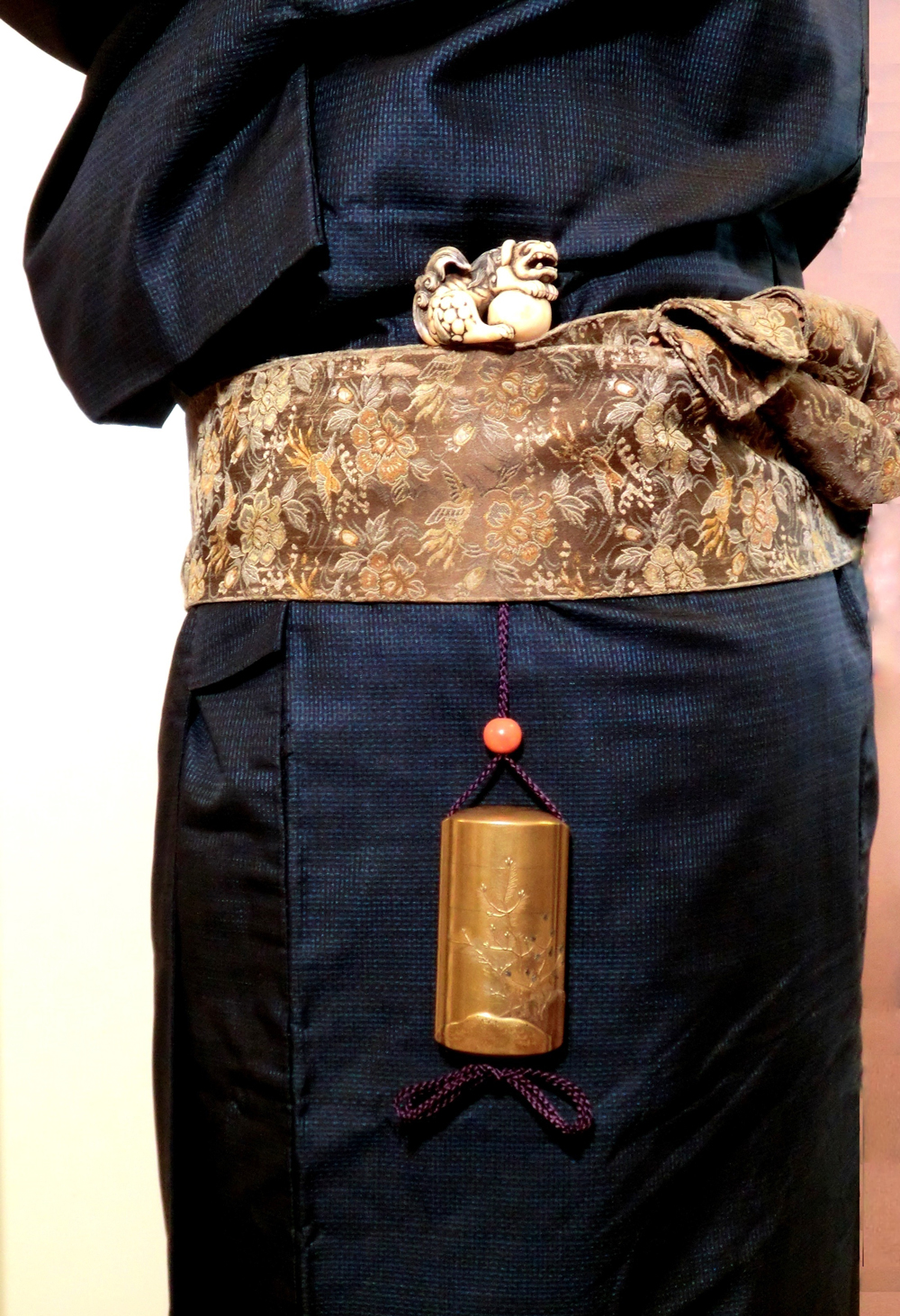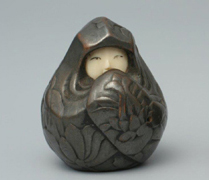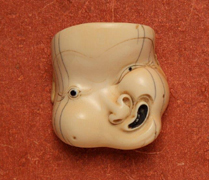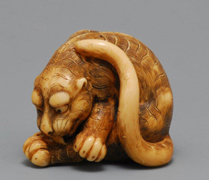TOP > About SAGEMONOYA > What are Netsuke ?
What are Netsuke ?
The traditional Japanese dress, the Kimono, has no pockets to carry small items such as purses, medicine boxes (Inro), portable writing sets (Yatate), tobacco pouches, etc.
Women carry them tucked in the sleeves, men suspend them on a cord passed behind their sash (Obi). These hanging objects are called Sagemono. To prevent them from falling, they are attached to a stopper called Netsuke firmly positioned on top of the sash.
The word Netsuke is written in Japanese with two characters (根付) meaning “root” and “attached”. It is therefore said that the first Netsuke were probably simple pieces of root or wood, or other natural materials such as shells, stones, etc. attached to the cord.
All small carvings are not Netsuke ! To be a Netsuke, the carving must have one or two holes (Himotoshi) to allow attachment to the Sagemono. These can be drilled or be a natural opening in the Netsuke design.
Over a period of about 300 years Netsuke have evolved from simple practical objects into superb small and intricate carvings appreciated and collected all over the world.

Types of Netsuke
Several type exist, mainly based on their shape.
- • Manju Netsuke. Named after a popular bean paste confection, round and flat in shape.
- • Kagamibuta Netsuke. Similar in shape to Manju, but with a lid (usually metal) on top of a hollowed bowl.
- • Ryusa Netsuke. Another variation of Manju, but with open-work carvings in order to make them lighter.
- • Katabori Netsuke. These three-dimensional Netsuke are the most popular ones, depicting people, animals, plants, objects of daily use, etc.
- • Men (mask) Netsuke. These are usually miniature renditions of traditional masks used during performing arts such as Noh, Bugaku, Kyogen or Gigaku.
- • Sashi Netsuke. Contrary to the previous types of Netsuke attached to relatively long cords, the Sashi Netsuke has a very short cord and is thrust between the sash and the Kimono. Their shape is thus long and flat.
- Other types of Netsuke have very often dual purposes, such as ashtray (Hihataki), brush holder (Yatate), boxes (Hako), abacus (Soroban), etc.
Materials used for Netsuke
It can be said that almost all materials can and have been used for Netsuke, but the most commonly ones are ivory, wood (especially boxwood) and antlers.
Others are boar tusks, porcelain, glass, metal, teeth, lacquer, woven cane and bamboo.
Rarer materials are hornbill, coral, narwhal, amber, tagua nut and various fossilised substances.
Netsuke subjects
 Subjects in all fields, real or imaginary, can be found in Netsuke.
Subjects in all fields, real or imaginary, can be found in Netsuke.
Animals, especially the twelve from the Zodiac calendar, are however the most popular subject. Mythical animals such as Kirin, Kappa and Dragons (a member of the Zodiac group) are also well in demand, but Shishi is the most common among them. Others like Hakutaku, Baku or Nue are much rarer.
All type of vegetables, flowers and fruits were carved, some with erotic meanings like mushrooms and cucumbers.
Subjects of daily life are also often represented, like peasants, fishermen, Ama (diving girls), masseurs, street vendors, Sumo wrestlers, blind men, monkey trainers, etc.
Foreigners such as Dutchmen and Chinese were represented, especially in the 17th and 18th centuries.
Another important group of subjects covers legends and myths often borrowed from China, including the 7 Gods of Good Fortune, Shoki the Demon queller and a myriad of Sennin (immortal persons). Japanese subjects come sometimes from Noh and Kabuki plays or folk tales. Tengu and Kappa are among the favorites creatures in this field.
Uncountable still life subjects were carved, such as tea ceremony utensils, helmets, baskets, coins, temple gongs, etc. The list is endless…
Shunga Netsuke show erotic subjects, sometimes explicit, more often hidden or only suggested.
Netsuke carvers
 The number of carvers is as uncountable as subjects. Some great carvers have never signed their works, especially during the early stage. Some became famous thanks to the first book (Soken Kisho in 1781) to list names of Netsukeshi (Netsuke carvers). They include well known artists such as Masanao, Tomotada and Garaku.
The number of carvers is as uncountable as subjects. Some great carvers have never signed their works, especially during the early stage. Some became famous thanks to the first book (Soken Kisho in 1781) to list names of Netsukeshi (Netsuke carvers). They include well known artists such as Masanao, Tomotada and Garaku.
In Japan, the history of Netsuke carving is usually divided in 3 periods:
- • Early period covering Netsuke from the 17th century to mid 19th century. For many foreign collectors, the 17th and 18th was the golden age of Netsuke carving, when many large and strong Netsuke were produced. This is the period when the Soken Kisho carvers flourished, to whom we can add such names like Yoshinaga, Okatomo, Minko, Tametaka and Tomotada. However for many Japanese collectors, carvers of the late Edo period (early to mid 19th century) are preferred. This was the time when rich merchants wanted to show their wealth by wearing luxurious ornaments such as Inro or tobacco pouches. These were attached to more finely carved Netsuke, at the cost of becoming more fragile and more easily damaged. To cite some famous carvers names of that period: Sukenaga, Toyomasa, Kokei, Ikkan, Sessai, Otoman and Tomokazu.
- • From Meiji period to the end of the Second World War (1868~1945). After the Meiji Revolution, the Government strongly recommended the population to adopt a more modern life style, including replacing the traditional Kimono with western clothes. The result was a rapid decrease in the demand of Sagemono and Netsuke. This was the time when many foreigners started to visit Japan and discovered the lure of these small works of art. This was a relief for the carvers who could again produce Netsuke to be exported in rather large quantities, mostly to Europe. Unfortunately the quality of such export Netsuke decreased and only a handful of carvers continued the traditional way of creating small masterpieces. These, even if they lost their original use, were highly appreciated as remarkable works of art by collectors, both in Japan and abroad. Master carvers such as Mitsuhiro, Tokoku, Kokusai, Kaigyokusai, Morita Soko, Sosui and Gyokuso were the most prized.
- • Later period (1945 until now). Obviously the demand for Netsuke fell during the Second World War, but it started again in 1946. Unfortunately most Netsuke carved during that period were mass produced in ateliers and should be considered as mere souvenir items, with no value except a sentimental one.
In the 70’s, Mr. Raymond Bushell, a foreign resident in Japan and collector of antique Netsuke, discovered Masatoshi (Nakamura), a promising Japanese carver, and became his sponsor. Mr. Bushell donated the major part of his collection to the Los Angeles County Museum of Art, including many works by Masatoshi. He has also published many books on Netsuke and Inro.
In the mid-70’s, some of the younger artists felt that they should be more creative. Just at that time, American collectors Robert and Miriam Kinsey encouraged artists to make Netsuke that reflected the present day. In 1977, Miriam authored the first major book on the subject of Contemporary Netsuke, and there was huge excitement amongst the artists. In June 1977, Kangyoku, Bishu, Hideyuki and Ryushi founded what is now the International Netsuke Carvers’ Association in order that professional Netsuke artists might exchange views and ideas. The names of the above artists as well as Meikei and Ikku became known abroad.
Mrs. and Mrs. Kinsey continued to support Japanese contemporary carvers, encouraging them and collecting their work throughout their lifetime.
Nearer to us, H.I.H. Prince collected and encouraged younger carvers by organizing many exhibitions all over Japan and sometimes abroad. H.I.H. Princess Takamado continues in this role.
Netsuke carving centers
 Over the centuries, Netsuke carvers tended to remain in certain regions in Japan, each having a distinctive style. The most important ones are (listed with a major carver): Kyoto (Masanao), Osaka (Kaigyokusai), Hakata (Otoman (Otomitsu)), Takayama (Sukenaga), Iwami (Tomiharu), Nagoya (Tametaka), Gifu (Tomokazu), Edo (Jugyoku), Ise (Masanao) and Tamba (Toyomasa).
Over the centuries, Netsuke carvers tended to remain in certain regions in Japan, each having a distinctive style. The most important ones are (listed with a major carver): Kyoto (Masanao), Osaka (Kaigyokusai), Hakata (Otoman (Otomitsu)), Takayama (Sukenaga), Iwami (Tomiharu), Nagoya (Tametaka), Gifu (Tomokazu), Edo (Jugyoku), Ise (Masanao) and Tamba (Toyomasa).
Netsuke studies and literature
As mentioned previously, the earliest listing of Netsuke carvers in Japan was the Soken Kisho published in 1781 by Inaba Tsuryu. This was followed, much later, by Netsuke no Kenkyu (Studies of Netsuke) written by Ueda Reikichi in 1943.
In Europe, serious studies about Netsuke started at the very beginning of the 20th century with publications by Brockhaus (1905), Bing (1906) and Behrens (1912). Since then many books have been published in Japanese, English, French, German and Russian by authors like R. Bushell, N. Davey and A. Ducros.
The latest book and bestseller related to Netsuke is The Hare with Amber Eyes by Edmund de Waal.



